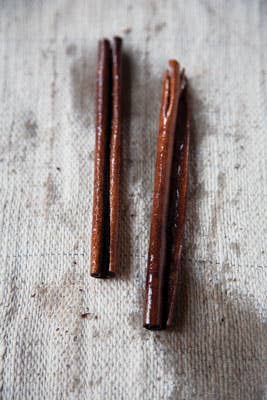
Sweet, Hot
I had a cinnamon moment ten years ago, in the mountains of the Mexican state of Oaxaca. At 9,000-odd feet above sea level, winded and tired, I stopped at a remote bodega. Inside, coffee was brewing in a ceramic pot; it was sweetened with piloncillo sugar and infused with a spice called canela in that part of the world. I recognized that spice immediately as cinnamon, but it took me by surprise nonetheless. One sip of the drink, tingly on the tongue and deeply warming, reawakened my senses to the spectacular mountaintop setting; beyond that, it got me thinking about a flavor I'd more or less taken for granted up to that point.
I went on to discover that what I'd tasted in Mexico was true cinnamon, a relatively mellow, subtly floral spice quite different from the one that I and most other Americans grew up eating in apple pie, cinnamon red hots, and cinnamon toast. That spice, it turns out, is cinnamon's punchier cousin cassia. I've since come to appreciate the different nuances and associations that each of these spices brings to my cooking—how a dash of cinnamon takes a meaty tomato sauce in a Greek direction, or how a spoonful of the spice transforms a pork hash into a zesty Mexican picadillo. A stick of cassia simmered in a pot of Vietnamese pho profoundly enriches and enlivens the beef broth. In bisteeya, the Moroccan pigeon pie, it's the gentle bite of cinnamon that binds the sweet and savory elements into a harmonious whole.
It's hard to look at a plastic container of cinnamon on the supermarket shelf and understand how valuable the stuff once was, but in premodern times, it was more than just a flavoring; it was a perfume fit for prayer or seduction, it was medicine, and, as Tom Standage notes in An Edible History of Humanity (Walker & Company, 2009), spices like it were "thought to be splinters of paradise that had found their way into the ordinary world." Both cinnamon and cassia were known in Europe throughout antiquity, though their sources were long kept secret. Contrary to Herodotus's fifth-century B.C. account—probably passed along by Arab spice traders jealously guarding their hold on the market—the spices were not stolen from the nests of giant birds or harvested from a lake infested with batlike monsters, but they did make extraordinary journeys to the West even so, sailing with the trade winds across the Indian Ocean or trekking overland across Asia.
Christopher Columbus, after reaching the islands of the Caribbean, wrote to his patrons in the Spanish court, "I believe I have discovered rhubarb and cinnamon." This was no small matter, as it was the demand for spices such as cinnamon, nutmeg, and pepper, above all else, that prompted 15th-century Europeans to launch their ships toward the New World. The adventurers who followed in Columbus's wake never found cinnamon or cassia in the Americas (the spices are native to Asia), but the far-reaching trade networks they mapped out ultimately made the spices both essential and easy to come by in kitchens around the world.
True cinnamon comes from a Sri Lankan tree of the species Cinnamomum verum (also called Cinnamomum zeylanicum) or, more precisely, from its oil-rich bark, which is hand harvested, scraped clean of its woody outer layer, and dried in delicate, multilayered quills (see A Pure Food); whole or ground, it has a mellow flavor, warm and sweet all at once. Cassia comes from several species of tree also belonging to the Cinnamomum genus, with significant harvests in Indonesia, Vietnam, China, and the Indian Subcontinent (see A Cinnamon Glossary). Its bark is thicker than cinnamon's, making for stiffer, sturdier quills. Cassia is sharper in taste, with a pronounced heat. It can also have a bitter edge and for that reason is often knocked as inferior to cinnamon. In truth, each spice offers its own advantages.
True cinnamon lends itself to slow stewing and steeping, as well as to sweet applications; its round, clean flavor never comes on too strong. Think of a pot of rice pudding with a couple of cinnamon sticks in it: the heat of the milk coaxes out the spice's lilting perfume. Mulled wines, sweet-toned Mexican moles, aromatic North African tagines, and chocolate desserts all benefit from the soft nuzzle of true cinnamon.
Cassia works well when you're looking to give a dish a bit of backbone or to offset sweetness with a good, spicy kick: in chutneys, Southeast Asian curries, and snickerdoodle cookies, to name a few. I take care not to overuse or overcook cassia, lest a dish develop the tannic bitterness that is the hallmark of bad cinnamon buns everywhere. To explore the character of both spices, make cinnamon toast with each one: both cassia and cinnamon have fat-soluble flavor compounds (notably, hot cinnamaldehyde and sweet eugenol) that bloom in the warm butter, but the toast topped with cassia will prickle with mild heat and pleasing bitterness, while the gentle taste of true cinnamon will linger quietly and sweetly on the palate.
Whichever spice I happen to have on hand, I still love to cook the dishes of my youth, but I also bring cassia and cinnamon to the table in other ways, in the hope that a wide-ranging culinary repertoire will help to nurture a broad worldview in my son and daughter. When they are older, my children will be nostalgic not just for cinnamon toast and apple pie but also for the fragrant red-braised pork of China's Hunan Province and Oaxacan hot chocolate infused with that cheering glow of canela.
Keep Reading
Continue to Next Story










